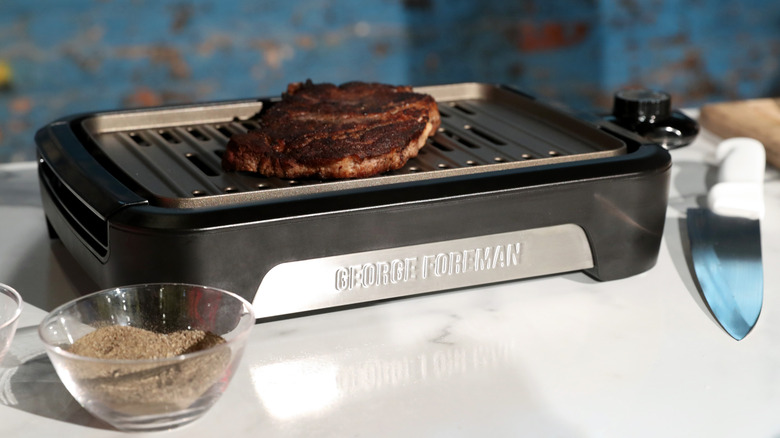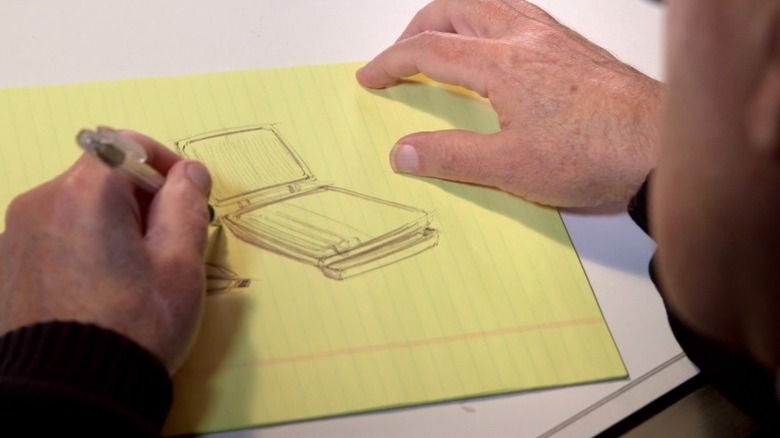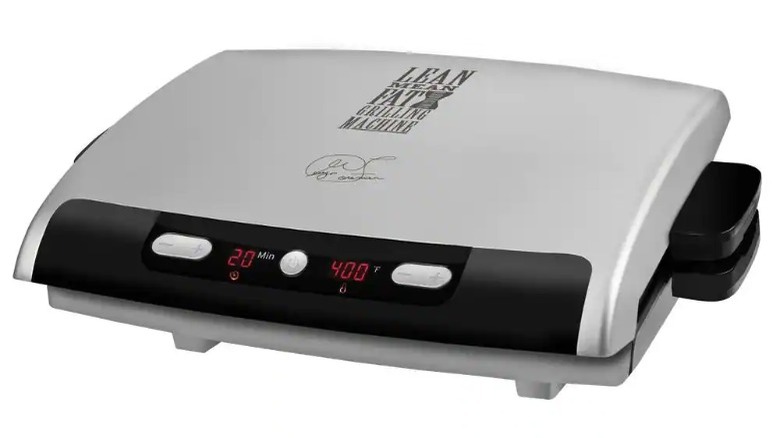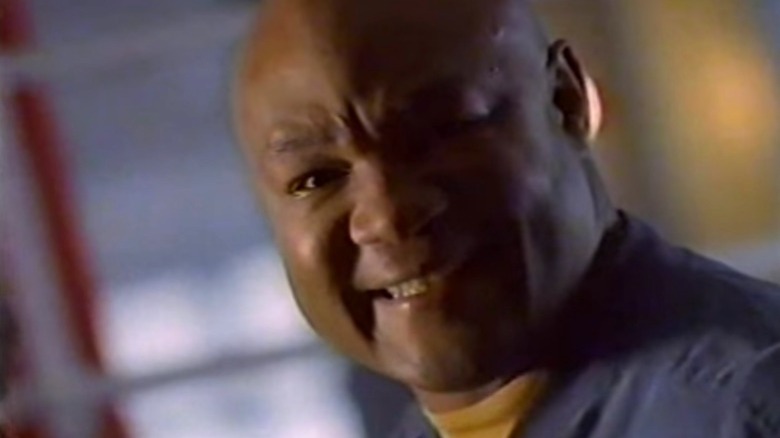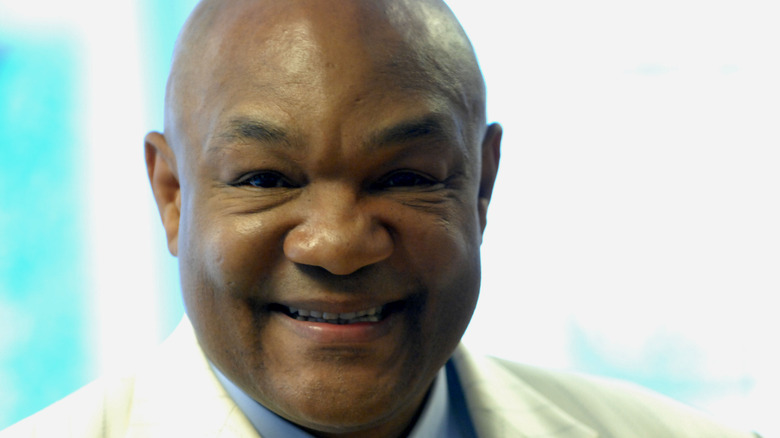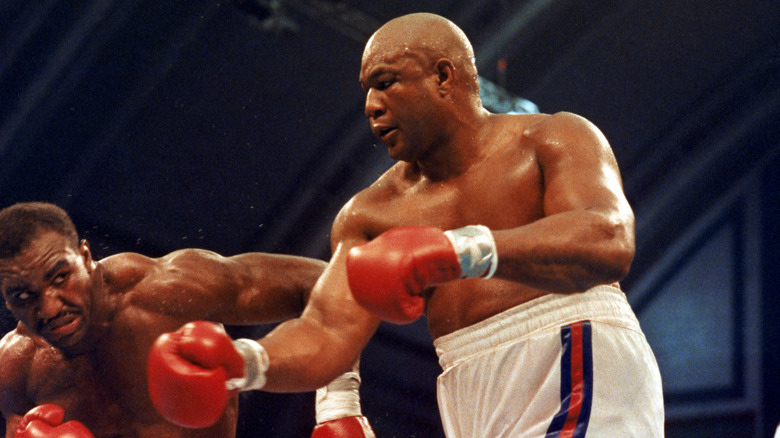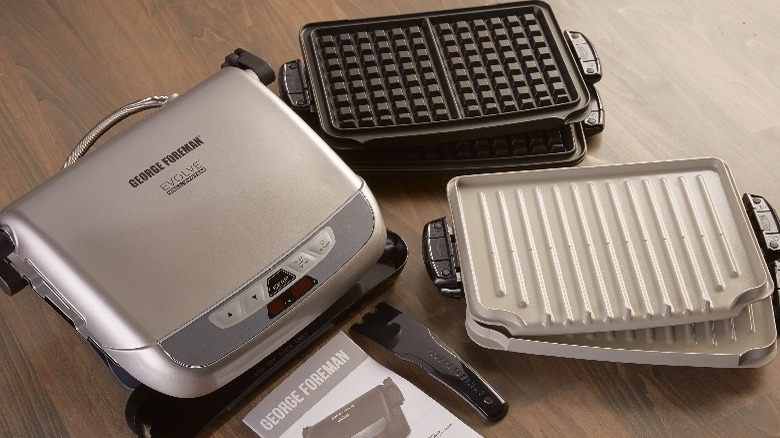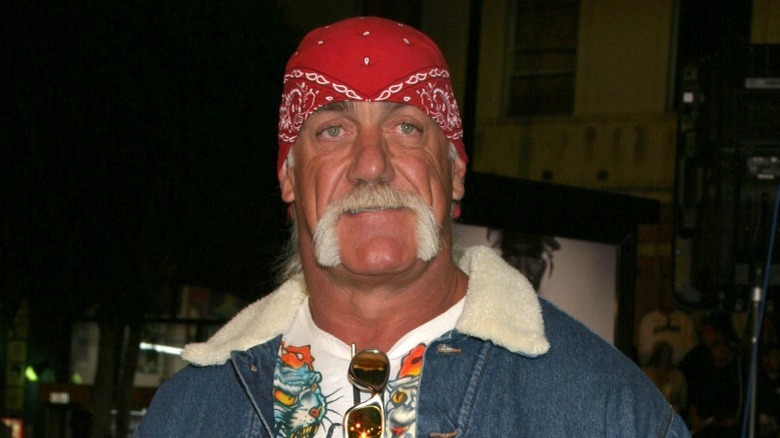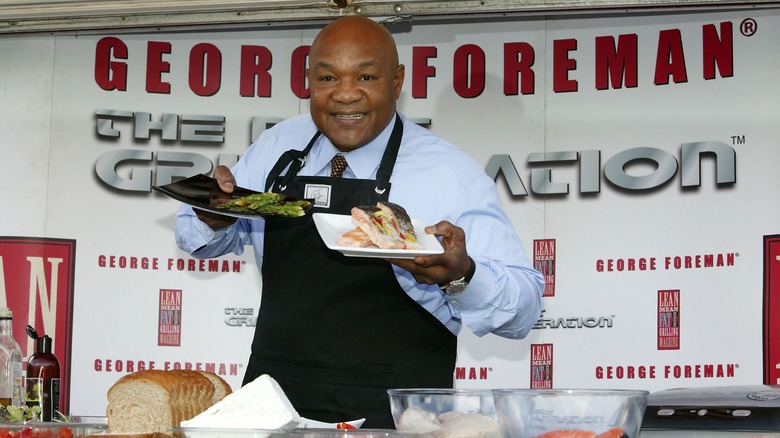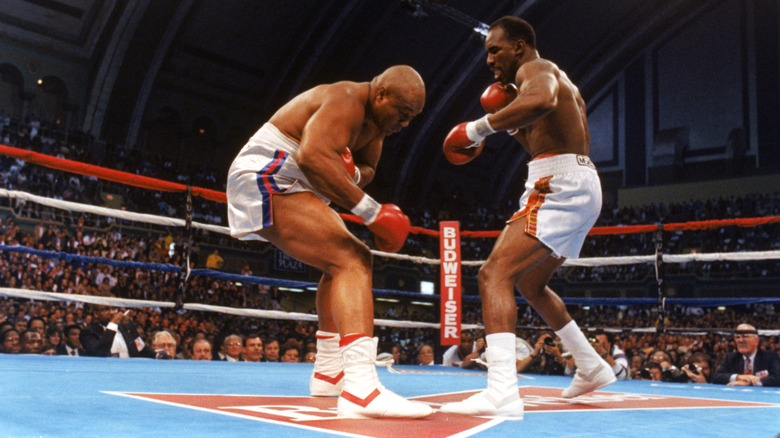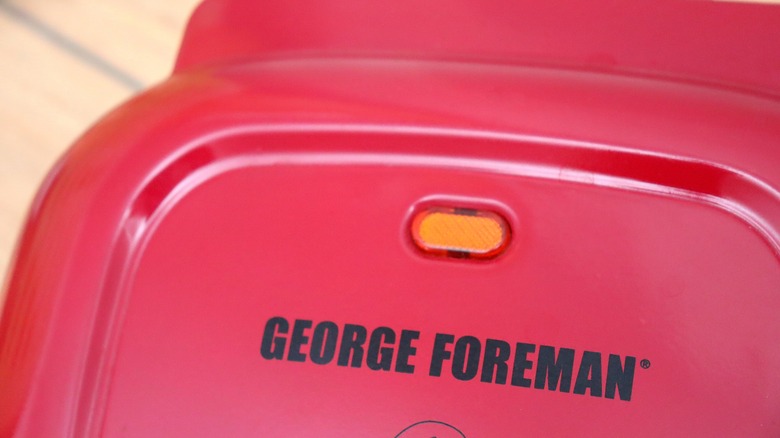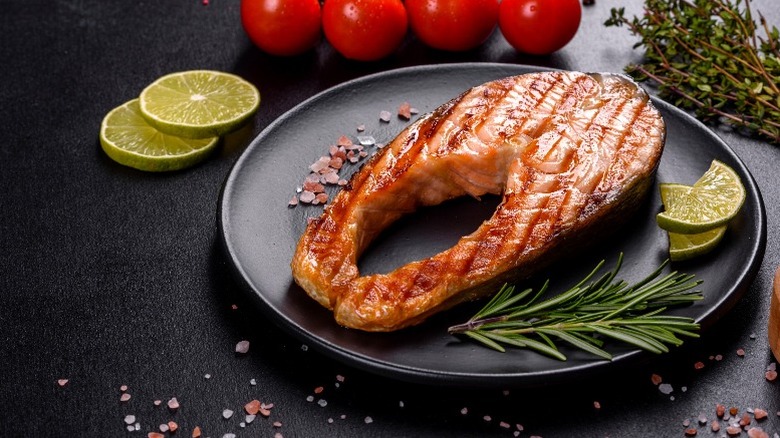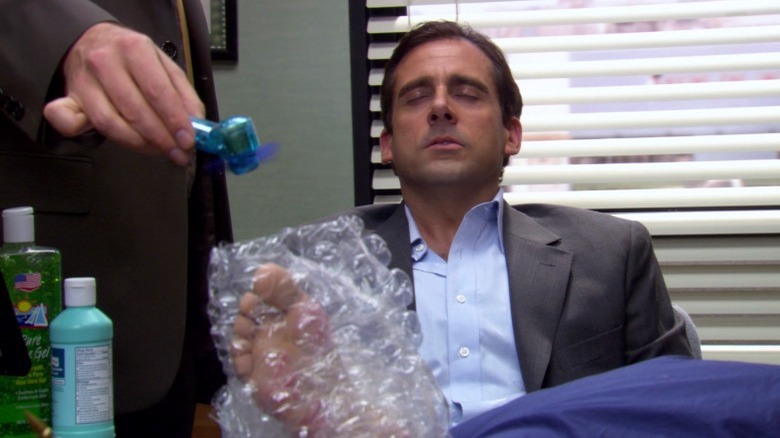The Untold Truth Of The George Foreman Grill
Dormitories. Office break rooms. Bachelor pads. What do these have in common? You probably don't have to look very hard to find a George Foreman Grill somewhere in all of those places. Over the years, the clamshell-like cooking appliance has become synonymous with easy cooking. All told, you only have to open it, add food, and close the lid, allowing the device to do the rest of the work. It's kind of like a book that can make you a steak ... and make it healthy, too, thanks to a tilted surface that allows grease to slide down into a drip tray. This makes the grill especially helpful when cooking bacon, by the way. As Foreman himself said in numerous ads, the Lean Mean Fat Reducing Grilling Machine "knocks the fat out." And he should know a thing or two about knockouts.
But how did such a ubiquitous device get its name from a world-famous boxer? And exactly how much money did said Foreman make from his namesake kitchen gadget? Well, consider the fact that over 100 million units have been sold since Foreman introduced the grill to infomercial viewers in the mid-1990s, according to the Smithsonian's Lemelson Center for the Study of Invention and Innovation, and you may begin to form your own answers. Read on to learn more about the conception of the George Foreman Grill, its rise to popularity, the copycats that it inspired, and much more. This is the untold truth of the George Foreman Grill.
George Foreman did not invent the George Foreman Grill
George Foreman has many skills, from the boxing ring to the screen, and even ministry. Electrical engineering, however, is not one of them. Despite its name, the George Foreman Grill is not strictly a George Foreman invention — he just helped popularize it. A man named Michael Boehm is actually responsible for coming up with the product.
Boehm had previously dabbled in patenting kitchen appliances, including a steamer-grill hybrid for Hamilton Beach (via Inventors Digest). Similarly, the idea for the George Foreman Grill came to Boehm from recognizing a widespread desire to cook favorite foods in a healthier way. His prototype, according to Entrepreneur, was made from a propped-up baking sheet. After some revisions, a patent, and several failed pitches, the appliance company Salton (now a part of Spectrum Brands) took on his idea.
Of course, Boehm didn't call it the George Foreman Grill right off the bat. Rather, its original name was the more plain Short Order Grill. The boxer entered the equation much later, when Salton tasked Boehm with signing on an endorser. Once everything was signed, Boehm's involvement was effectively completed. According to Inventors Digest, he did not receive royalties from its eventual success.
George Foreman Grill is shorthand
Capitalizing on its health benefits as its main selling point, the official name of the original product is a bit of a mouthful: George Foreman's Lean Mean Fat-Reducing Grilling Machine. "It's a big name for a little machine," comments Nancy Nelson in one of the first infomercials for the product. As time passed, more concise branding became en vogue, but the grill remained popular, so the newer models now available on the company's website have more simplified names. The wordy title no longer appears on the product. Instead, most just say "George Foreman" and occasionally include, like the first version, an image of his signature. "When you do something and sign your name, that means you really believe in something," he tells Nelson in the aforementioned paid programming.
Average customers might be more prone to call the device simply a "grill" over a "grilling machine," but that didn't stop comedy series "30 Rock" from sending up the name. In the Season 1 episode "The Rural Juror," we're introduced to the rather alarmingly-named "Tracy Jordan Meat Machine." The fictional product is clearly a reference to George Foreman's household appliance, right down to the signature on the packaging. Say it with us, now: Meat is the new bread!
The grill wasn't Foreman's first product endorsement
George Foreman was no stranger to lending his likeness to a product by the time he got his hands on the Lean Mean Fat-Reducing Grilling Machine. A year before the grill made its 1995 infomercial debut, Foreman was already a familiar face during commercial breaks, thanks to his endorsement deal with auto repair company Meineke.
In the ad, Foreman evokes his ringside gruffness to help a man find the aggression and indignation he needs to proclaim, "I'm not gonna pay a lot for this muffler." Foreman even sneaks in a "My Fair Lady" reference once the man finally voices his budget for car parts with sufficient austerity, saying to the camera with his trademark grin, "By George, I think he's got it."
The boxing champion continued to help hawk car parts well throughout his association with the grill. According to Charlotte Business Journal, Foreman's contract with the North Carolina-based Meineke was renewed in 2004 through 2010, with his duties including TV, radio, and print ads, and convention appearances.
Foreman's wife gave him the motivation he needed
When Michael Boehm sent George Foreman a prototype of the grill to gauge the boxer's interest in becoming its product spokesperson, Foreman shrugged off the idea. "I took a look at it and said, 'I'm not interested in toys,'" Foreman told CNBC. Yet he kept the prototype, which sat unused for half a year in his home. This ultimately meant that the first person in his household to actually use it wasn't him, but rather his wife, Mary Joan Martelly. She was into the kitchen gadget and found it especially useful for making fast and kid-friendly meals like grilled cheese sandwiches.
To get Foreman on board, Martelly whipped out the grill and made her husband a hamburger, according to Adweek. Clearly, it was a hit, as it convinced Foreman to reconsider Boehm's proposal and throw his name on the product. So Boehm may have come up with the machine and Foreman may have introduced it to the masses, but Martelly was the one who connected the dots. We have her — and one particularly delicious hamburger — to thank.
A royalties check pushed Foreman to quit boxing
The George Foreman Grill's success arrived in the middle of the boxer's successful return to the ring. He had initially retired as an athlete in 1977, a decision that was born out of a spiritual epiphany following a defeat by Jimmy Young. Soon after, as his official website explains, he became an ordained minister. During his comeback, he secured a second world championship title, but in 1997, a defeat by Shannon Briggs proved to be Foreman's true final fight. Just like his '77 loss led to a life-changing revelation, the '97 blow changed Foreman's course from that of a prizefighter to a full-time businessman.
In his memoir "Knockout Entrepreneur," Foreman recalls that immediately following the Briggs fight, when asked for a reaction, he took the opportunity to plug the Lean Mean Fat-Reducing Grilling Machine. "The way I figured," he writes, "I had a microphone in front of me, and this was my chance to make something good out of a bad situation" (via TODAY).
Back in the locker room, according to CNBC, his lawyer presented him with an oversized royalties check for a million dollars. "That was one of the happiest days of my business life," Foreman says. Sure, he may have been saying goodbye to his sports career, but it still doesn't sound like much of a loss to us.
Accessories make the grill even more useful
If you're only using the George Foreman Grill to make burgers, then you're doing it wrong. As the grill's popularity grew, so did the number of dishes it could help bring to the plate. Removable grill plates were introduced in 2004 with Foreman's "The Next Grilleration" line, and in 2014, the company came out with the Evolve Grill System. With that development, not only could you remove the dishwasher-safe plates for easy cleaning, but you could swap them out to make different dishes.
On top of a grill and panini press, the Evolve version has the capacity to act as a waffle iron, a griddle, an omelet station, and even a muffin maker. When cooking eggs or batters, just remember to adjust the grill's tilt position so that the liquid doesn't ooze down into the drip tray. Now if we can just find a way to have it brew coffee, we'd have a true one-stop breakfast machine.
The George Foreman Grill haunts Hulk Hogan
Fellow pro fighter Hulk Hogan has a long and convoluted history with the George Foreman Grill, claiming that he was supposed to be the face of it instead. According to the famous wrestler, either a missed call or a regrettable business decision is the reason we know the device as the George Foreman Grill and not the Hulk Hogan Grill.
According to Wrestling Inc, Hogan went up to "Avatar" star Sam Worthington at 2011's Comic-Con (the initial motive for this interaction remains unclear) and offered some business advice: pick your endorsement deals wisely. During that exchange, Hogan reportedly recalled to Worthington that, in the '90s, his manager had a couple of proposals for him. Namely, there were two kitchen appliances that Hogan was reportedly approached to endorse: a meatball maker or a certain two-sided grill press. You probably don't need us to tell you he did not pick the grill. In another version of this anecdote, as reported by Fox Sports, Hogan says the reason he missed out on the grill was simply that he missed a call from his (and Foreman's) attorney. By the time the Hulk returned the call, Foreman had already called dibs. Michael Boehm's wife Julie denies both of these claims, as Inventors Digest reports.
Fortunately for Hogan, he eventually got his own grill, deemed "Hulk Hogan's Ultimate Grill." Unfortunately for Hogan, the U.S. Consumer Product Safety Commission eventually recalled it because the product was deemed a fire hazard.
Foreman officially left the deal in 1999
By 1998 (just one year after Foreman's re-retirement from boxing), the George Foreman Grill reached $200 million in sales, according to The New York Times. This made the grill Salton's most popular product, and through all of those sales, Foreman and his partners were collecting 60% of the profits. That changed in 1999, when the company bought them out for a whopping $137.5 million.
With that final payday, Foreman was out, though his likeness was not. Salton retained the worldwide rights to use his name and image, and Foreman continued to pop up for occasional appearances in ads (including two Super Bowl commercials, per the Super Bowl Ads Database Archive).
How did things pan out? Ultmately, Celebrity Net Worth estimates Foreman's net worth at $300 million. Looking at his massive royalties cut and that buyout sum, it's no surprise that Foreman's wealth primarily came not from boxing (though he wasn't too shabby at that) but from selling kitchen appliances. In fact, he told the AARP that he made "much more" than $200 million from the grill. It may be a mean, lean machine, but that is most definitely a nice, fat sum.
Copycat brands followed
In Season 8 of "The Real Housewives of New York City," Skinnygirl guru Bethenny Frankel accused Sonja Morgan of ripping her off when the latter attempted an (ultimately unsuccessful) launch of a "Tipsy Girl" prosecco. Frankel used the term "cheater brand," leaving Morgan in tears. Perhaps unsurprisingly, the world of wine-sipping Manhattanites is not far off from that of competitive fighters.
After the undeniable success of the George Foreman Grill, suspiciously similar appliances began to hit the airwaves and shelves, many with athletic heroes in tow. Evander "The Real Deal" Holyfield, who had actually defeated Foreman in the ring in 1991, promoted the appropriately named Real Deal Grill, per Gizmodo. Track and field olympian Carl Lewis had the Health Grill. Hulk Hogan had his aforementioned (and recalled) Ultimate Grill. Yet, none held a candle to Foreman's Lean Mean Fat-Reducing Grilling Machine.
The one exception was perhaps the Jackie Chan Grill, though that kitchen appliance is not actually a copycat. Instead, it is simply a rebranding of the George Foreman Grill for Asian markets, as Appliance Retailer reported.
Shady sales tactics have landed Foreman's grill in hot water
In 2002, grill sales were still going strong, having reached a very respectable $400 million, according to CNN. But some retailers took issue with the practices that contributed to the brand's success. A 2002 lawsuit settlement led to Salton paying $8.2 million in damages. At the time, The Chicago Tribune reported that the case, brought forward by attorneys general in 44 states (plus Washington, D.C. and Puerto Rico), alleged that the appliance company was using "anti-competitive practices" to boost numbers.
Among those tactics, the suit claimed, was pressuring retailers to not reduce the price of the George Foreman Grill in their stores, so that it matched the $59.99 price advertised in the product's own advertising. The Federal Trade Commission calls this practice, known as price fixing, "a major concern of government antitrust enforcement." The suit also alleged that Salton did not allow stores to stock similar models from competing brands, and would go so far as to discontinue supplying the stores with the Foreman grills if they did not comply.
Foreman's favorite thing to cook on the grill isn't red meat
The George Foreman Grill is perhaps most commonly associated with greaseless (but still flavorful) burgers. The original infomercial used burgers to demonstrate its fat-reducing powers. And remember that his wife first convinced him of the product's promise with a burger, after all. However, they're not Foreman's favorite thing to cook on his namesake machine.
Foreman will tell anyone who asks on social media that his favorite way to use the appliance is to grill salmon steaks. In fact, he's gone so far as to call salmon (seasoned with salt, pepper, and garlic) "the most dreamy thing I've done on the GF Grill." He's also been known to grill some of the fish and serve it with bagels and cream cheese. While this is technically a deviation from the grill's primary branding, the choice of protein isn't that much of a shocker, given Foreman's focus on nutrition. Eating salmon has plenty of health benefits, thanks to the fish's plethora of omega-3 fatty acids.
The grill is the star of an episode of The Office
There's no denying that television played a huge part in the popularization of the George Foreman Grill. But infomercials are only part of the appliance's remarkable relationship with the medium. The grill took on a starring role in one of the most popular episodes of a very popular long-running sitcom: "The Office."
Season 2's "The Injury" opens with Michael Scott (as played by Steve Carell) calling his fellow Dunder Mifflin employees in excruciating pain, having burnt his foot on his George Foreman Grill. How did his foot get ensnared in the clutches of what was, essentially, a smoking hot bear trap? Well, he uses it every morning to make bedside bacon. Ignoring the bacteria-laced hazards of leaving raw bacon strips out overnight, it's an ingenious move ... until you get out of bed and step directly onto the device.
Between the ensuing pity party and the one-upmanship against a concussed Dwight, Michael's antics helped make this episode one of the comedy's most celebrated to this day. The creators love it, too. Mindy Kaling, who wrote the episode (and played Kelly Kapoor), says it's her favorite of the series, calling it "full-on loopy" in an interview with Vulture. In a roundabout way, George Foreman and his eponymous cooking device are in part to thank for the story's success.
